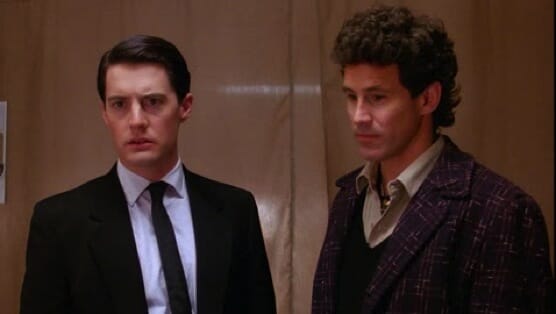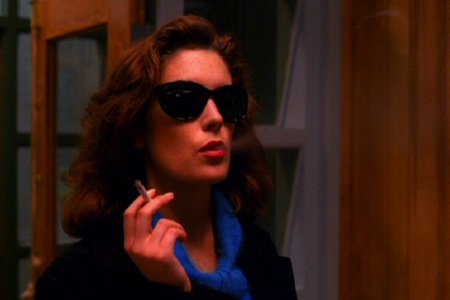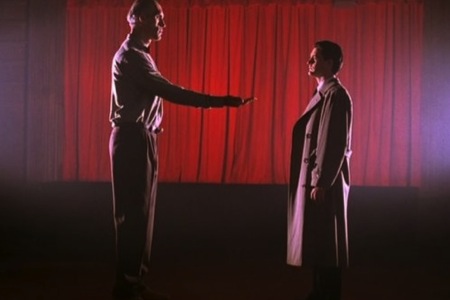Twin Peaks: The Complete Series

With the recent announcement of a new season of Twin Peaks headed our way in 2016, we figured it was a good time to relive the magic. Consider this, also, our response to all of those ‘What’s a Twin Peaks?’ tweets that went out yesterday. One of our top eight show of the 1990s, at the very least, the reboot of David Lynch’s classic will introduce the series to the contemporary crowd, with their iPhone 6s and lack of critical 90s pop culture knowledge.
Without further ado, here’s our five-part review of the entire Twin Peaks series.
I. The Pilot
Despite the recent blu-ray release of Twin Peaks, dubbed “The Entire Mystery,” the television show and movie remain strangely fragmented affairs, made in different years by different people and with wildly differing end results. The first Twin Peaks project, the feature-length (94 minutes) pilot, was shot in 1989 on location in areas of Washington near Seattle. David Lynch and Mark Frost worked together on the prompting of their mutual agent, though it was only after their feature film ideas fell through that they ended up pitching a TV series to ABC. In their 20-minute pitch meeting, Lynch and Frost detailed their radical new ideas for a prime-time soap opera, combining traditional elements of that genre with those of a police investigation. More than that, they rode on sheer atmosphere, as Lynch stressed abstract concepts like the dread of wind passing through the trees and the image of a girl found dead wrapped in plastic. Given the combination of Lynch’s recent success with the somewhat similar Blue Velvet and Mark Frost’s experience on Hill Street Blues and The Six Million Dollar Man, it was no surprise that ABC gave the pair a $1.8 million budget to go shoot their idea.
There’s a certain seriousness to the pilot, especially the first half, that’s a bit out of character for the show that followed. The proximity to Laura Palmer’s death is the primary cause of this, but for a long time there’s little sign of the strange humor that characterized Twin Peaks just as much as its looming dread. A lot of this comes from one of its other oddities: the star appearance of Kyle MacLachlan about 35 minutes into the show. Structurally, the pilot refuses to be categorized as a television series. The refusal to connect its cast, or to offer the audience any sort of compass with which to tell what direction Twin Peaks was headed, went against conventional wisdom. When Dale Cooper finds letters under the nails of a deceased girl, and the moment when the barking of teenage boys turning into subhuman howls showed that whatever else Twin Peaks was interested in, it wasn’t just about solving a murder.
II. Season One

As the first proper episode of Twin Peaks begins, we have Dale Cooper sitting in his hotel room, speaking to “Diane” on his tape recorder, and talking about how “damn fine” the local coffee is. However, something has changed: Cooper wonders aloud about the assassination of John F. Kennedy, rather than the murder of Laura Palmer, signaling a sea-change for the show.
That isn’t to say that the first season of Twin Peaks isn’t centered on Laura Palmer, or that it’s not as thematically concerned with death, evil, and violence against women as what came before, but this is now leavened by humor and diffused by a growing network of side stories. Already, Twin Peaks is a soap opera. There’s hardly any character without at least one extra love interest, and these triangles only become more complicated as things move forward. This isn’t a bad thing, though, as throughout the first season all of these stories are also tangled up with Laura, whose presence haunts the show in more ways than one with the arrival of Maddy, her identical cousin (also played by Sheryl Lee).
Violence against women is ubiquitous in this season, and every subplot concerns the possibility of its return, most overtly with the introduction of Shelley and her abusive husband, Leo. Laura and Ronnette’s tragedies were the first, but the intimation is that, with or without BOB’s assistance, the Twin Peaks area is infected with an angry misogyny that’s just waiting to kill any of the female citizens. Even within the dullest side plots, it’s the constant threat of violence that keeps the quirks in check. The oddities never feel unnecessary here, or forced. Rather, it’s matter-of-fact, the surface rippling that signals us to the beast below. This lack of subtlety is often what’s so jarring about the show’s content. In the world of Twin Peaks, an obvious doubling of a dead girl or a character breaking down into tears while dancing in public aren’t just odd, they’re necessary—symptoms of a town and world gone awry.
-

-

-

-

-

-

-

-

-

-

-

-

-

-

-

-

-

-

-

-

-

-

-

-

-

-

-

-

-

-

-

-

-

-

-

-

-

-

-

-










































